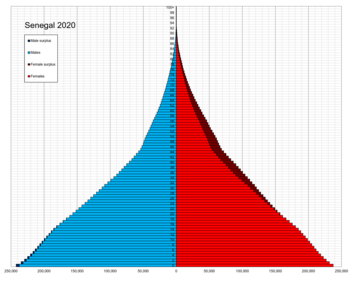| Demographics of Senegal | |
|---|---|
 Population pyramid of Senegal in 2020 | |
| Population | 17,923,036 (2022 est.) |
| Growth rate | 2.57% (2022 est.) |
| Birth rate | 31.51 births/1,000 population |
| Death rate | 5.08 deaths/1,000 population |
| Life expectancy | 69.96 years |
| • male | 68.23 years |
| • female | 71.77 years |
| Fertility rate | 4.27 children |
| Infant mortality rate | 32.44 deaths/1,000 live births |
| Net migration rate | -0.71 migrant(s)/1,000 population |
| Sex ratio | |
| Total | 0.97 male(s)/female (2022 est.) |
| At birth | 1.05 male(s)/female |
| Nationality | |
| Nationality | Senegalese |
| Language | |
| Official | French |
Demographic features of the population of Senegal include population density, ethnicity, education level, health of the populace, economic status, religious affiliations and other aspects of the population.
About 42% of Senegal's population is rural. In rural areas, population density varies from about 77 per square kilometer (200/mile²) in the west-central region to 2 per square kilometer (5/mile²) in the arid eastern section. The average population density for the country is 68 people per square kilometer (180 people/sq mi).[1] French is the official language but is used regularly only by the literate minority. Almost all Senegalese speak an indigenous language, of which Wolof has the largest usage. Many Senegalese live in Europe, particularly in France, Italy and Spain.